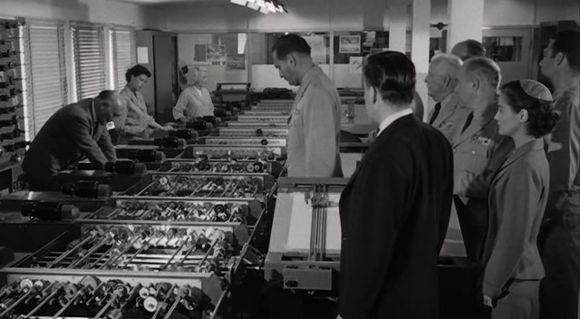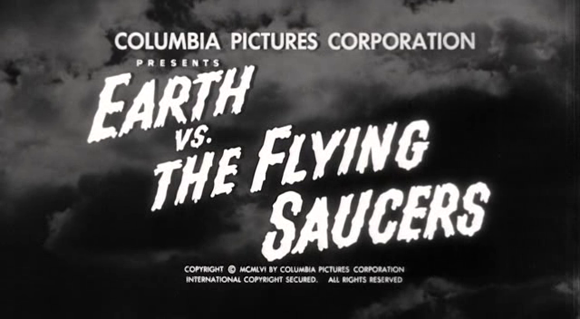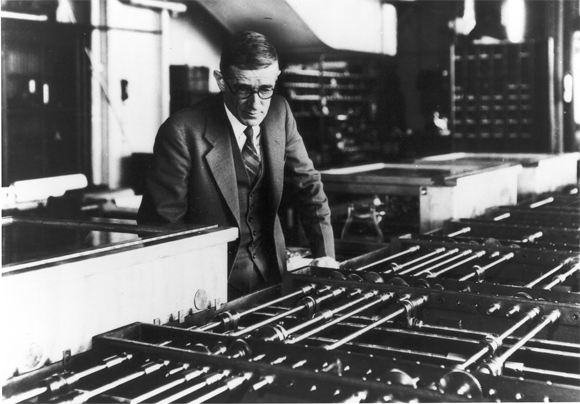what is that?
zeph’s pop culture quiz #45

What is the large mechanical contraption in the picture everybody is staring at? In which movie does it appear and what does it do within the plot of that movie?
Just leave a comment with your educated guess—you can ask for additional hints, too. [Leaving a comment is easy; just click the ‘Leave a comment’ at the end of the post and fill in the form. If it’s the first time you post a comment, it will be held for moderation. But I am constantly checking, and once I’ve approved a comment, your next ones won’t be held, but published immediately by the system.]
UPDATE and solution (09 October 2012):

Once again Alexander Rabitsch ↵has done it: The machine is a Bush Differential Analyzer. About one hour into ‘↵Earth vs. The Flying Saucers‘ (Sears 1956) it helps to decrypt a message from the aliens. The machine seen in the movie belonged to the ↑UCLA and was installed there in 1947. The machine was the child of ↑Vannevar Bush (1890-1974) who had begun to work on this kind of analogue special purpose computers during the late 1920s.
‘My main effort was on the differential analyzer, which could mechanically solve differential equations.’ (Bush 1970: 161) Accordingly in 1927 Bush at ↑MIT starts to construct a practical version of the Differential Analyzer as invented by ↑James Thomson (1822-1892), elder brother of mathematical physicist and engineer ↑William Thomson, 1st Baron Kelvin (1824-1907). Once finished, in 1930, this analogue computer proofs to work flawlessly and is able to solve differential equations comprising up to 18 independent variables. (Puchta 1996)
A young doctoral student at the MIT is involved in the project—↑Claude Elwood Shannon (1916-2001). For his thesis he takes ‘the application of the techniques of classical Boolean algebra of classes to the study of switching systems in electrical engineering,’ (Wiener 1965 [1948]: 13) and thus creates digital circuit design theory.
‘We actually built three successive analyzers. The first one was just a breadboard machine. That is, it was made out of pieces of steel and anything else that was handy, […]‘ (Bush 1970: 182)—improvisation, and, much more important, rededication again.
During the 1930s Bush Analyzers are built in Great Britain, at Manchester, Cambridge, Belfast, and Farnborough, and in Oslo, Norway. During the early 1940s more incarnations follow in the United States, e.g. at Wright-Patterson Air Force Base and in the basement of the Moore School of Electrical Engineering at the University of Pennsylvania.

In 1941 an advanced version is constructed at MIT, called the ‘Rockefeller Differential Analyzer’ (RDA), because the Rockefeller Foundation largely has funded this apparatus of Babbageian dimensions, weighing 100 tons, comprising ‘2,000 electronic tubes, 200 miles of wire, 150 motors, and several thousand relays.’ (Wildes & Lindgren 1985: 92) Its predecessors are hard to set up for solving a particular problem, because the procedure requires e.g. manual reconnection of shafts. The RDA in contrast reads its instructions from three punched tapes.
With Vannevar Bush’s Differential Analyzer the story of the analogue computer, which started with the ↵Antikythera Mechanism, has come full circle and reaches its full bloom.
Nearby Hollywood also discovered the oversized computer [at UCLA], measuring some 31 feet long by 9 feet wide. In the era before “Star Wars” [Lucas 1977] and “Close Encounters” [Spielberg 1977] the differential analyzer was the latest in way-out gadgetry, and it performed skillfully in such science fiction epics of the mid-’50s as “When Worlds Collide” [Maté 1951] and “Earth vs. The Flying Saucers.” (Anonymous 1978)


No idea what movie it’s from, but has it something to do with decrypting Enigma?
No, the contraption depicted played no role whatsoever in braking the Enigma cypher, but it is from the same era. And it did play a role in the history of the computer as we know it today. In fact, the machine we can see in the screencap is not a movie prop, but the real thing.
it looks lika a Zuse Z1
No, sorry, it is not—correct era but wrong continent. Above that the depicted machine, on the level of basic principles, is fundamentally diverging from the Z1.
This machine is an Differential Analyzer ( http://en.wikipedia.org/wiki/Difference_engine ). Movie: Earth vs. Flying Saucers a/k/a >>Fliegende Untertassen greifen an<< 1956
Oh yes, it is used for translating the Aliens´ message ….
This, of course, is absolutely correct—congratulations! Well done, I have to say. I’ll update the post accordingly.
;) Your article on the difference engine was the spring board :D This machine (and its sad history) was so fascinating … I really absorbed anything connected with this thing. First of all Gibsons and Sterlings novel … and the Lego-thing. I mean if you even think of the Antikythera mechanism 60 b.c. … but those things weren´t developed further … amazing what the mind can bear and how easy ignorance can destroy it ….